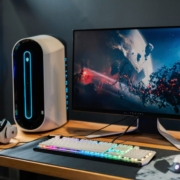When Will PC Demand Rebound?
COVID-19 drove dynamic changes in both the supply and demand sides of the PC market. During the onset of the pandemic, PC OEMs across the industry forecasted robust reductions in demand, tempering production targets and inventory orders. However, in the latter half of 2020, it became apparent that these demand forecasts were materially lower than the real demand for PCs.
Sudden Increase in Demand Challenges an Already Constrained Supply Chain
The pandemic forced lockdowns and closures of educational institutions and corporate offices, driving learn- and work-from-home trends that made PCs a necessity. The same lockdowns and closures caused supply chain constraints both upstream and downstream of the PC OEMs. Component manufacturers raced to ramp up production and shipments of their goods as new orders came in rapidly due to suddenly higher demand, which created similar challenges for logistics companies.
To make matters worse, PC OEMs and companies in most other industries around the world leveraged a growing amount of transactional data to optimize supply chains around the just-in-time (JIT) workflow methodology, which aims to reduce costs by manufacturing and delivering goods to meet supply without creating a surplus. As such, a JIT approach relies heavily on demand forecasting and limits organizations’ flexibility. When PC demand forecasts jumped suddenly, this created myriad challenges throughout the entire supply chain. PC order backlog began to build as demand outpaced supply and PC prices increased.
This imbalance also drove PC OEMs to increase production targets as they raced to grow their share in the demand-rich market environment. This increased stress on the supply chain while also raising supply chain costs with respect to componentry and logistics. At the time, PC OEMs were able to largely pass these costs on to the consumer, as price competition was almost nonexistent due primarily to constrained supply as well as government stimulus payments that helped support consumer and commercial demand.
As the Market Saturated, Vendors Were Left with Glut of Inventory
Over time, though, supply chain conditions improved and PC order backlogs and lead times started to normalize. Market demand was largely satisfied, and PC OEMs were stuck with a glut of inventory in both the factory and the channel. This marked an inflection point in the PC market as supply now outpaced demand.
PC OEMs now had a single priority: clear excess inventory, while PC buyers became inundated with a wide variety of available offerings across the market. Naturally, this led to a more price-competitive market environment as price elasticity in the market increased rapidly after being quite negligible for several consecutive quarters. As such, PC margins began to fall in parallel with PC unit shipments. Excess channel inventory levels spurred aggressive price competition, particularly in consumer PC, and channel sell-in demand deteriorated. These factors led to massive top-line contractions among PC OEMs, necessitating the rebalancing of resource spend and, in many cases, layoffs to mitigate operating margin erosion.
As excess inventory is digested and as channel inventory levels normalize, TBR expects a slight easing of price competition in the PC market, which will positively impact margins, all else being equal. However, average life spans of today’s PCs range from three to eight years, and many new PCs were purchased during the pandemic. Additionally, as we transition to a post-pandemic world, new macroeconomic uncertainties, including high inflation, rising interest rates and fluctuating foreign exchange rates, have come to light, reducing consumers’ and organizations’ willingness to spend. For these reasons, TBR expects PC demand will remain low until the next PC refresh cycle, improving only incrementally as macroeconomic uncertainty eases.
So, When Will PC Demand Rebound?
TBR strongly believes a material rebound in the PC market will only begin in conjunction with the next major refresh cycle. However, this is dictated by several factors.
The optimistic case: Macroeconomic conditions improve and the major PC refresh cycle begins in the back half of 2023.
- Inflation in the U.S. cools due to the Federal Reserve’s prior interest rate hikes.
- The Federal Reserve ceases Federal Funds Rate increases and begins rate reductions.
- Consumer sentiment increases and corporate budgets loosen.
- Stabilization of countries’ central bank rates reduces foreign exchange rate volatility.
The pessimistic case: Macroeconomic conditions worsen and the major PC refresh cycle is pushed back.
- Inflation in the U.S. remains elevated.
- The Federal Reserve continues to increase the Federal Funds Rate.
- Consumer sentiment remains weak, potentially worsening, and corporate budgets remain tight, possibly contracting even more.
- Foreign exchange rate volatility remains high.
Other Factors That Could Influence PC Demand
Sunsetting of Windows 10
Windows 10 support will end on October 14, 2025. Customers with machines running Windows 10 will be motivated to upgrade to a machine running Windows 11.
Killer Application: AI
The use of AI has proliferated in line with the exponential rise in data generation. Additionally, the buzz around generative AI has gained significant momentum, piggybacking on OpenAI’s recent release of ChatGPT. Today, most AI workloads are run in the data center; however, PC OEMs are rapidly investing in the development of machines purpose built to run AI workloads at the edge. As more AI applications are developed for PCs, an increasing amount of AI workloads will transition from the data center to the edge, heightening demand for new and more capable PCs. However, the impact of this development largely depends on the development rate of AI applications for PCs as well as their use-case validation.
Geopolitics
The war in Ukraine has had a net-negative impact on PC demand in the EMEA region. Moreover, friction between the U.S. and China, primarily as it relates to Taiwan — debatably the most important country in the PC supply chain — has caused uncertainty among PC OEMs and customers alike. Should U.S.–China or Russia–Ukraine relations deteriorate further, it is more likely that the refresh cycle will be pushed back, primarily regarding corporate budgeting.
More Comprehensive PC Support and Maintenance Offerings
PC services fetch larger margins than PC hardware sales. As such, PC OEMs continue to strengthen their portfolios of support and maintenance offerings, which generally extend the life span of PCs. Should consumers and organizations choose more extended warranties and support services, the PC refresh cycle will be pushed back.
Considering these possible developments and their respective impacts on the market, TBR currently predicts that the PC market will return to quarterly year-over-year revenue growth sometime around the second quarter of 2024.
To learn more about our expectations for PC demand rebound, watch our recent webinar “Navigating Soft Demand and Margin Erosion: Insights into Devices Vendors’ 2022 Revenue Challenges” for free now



